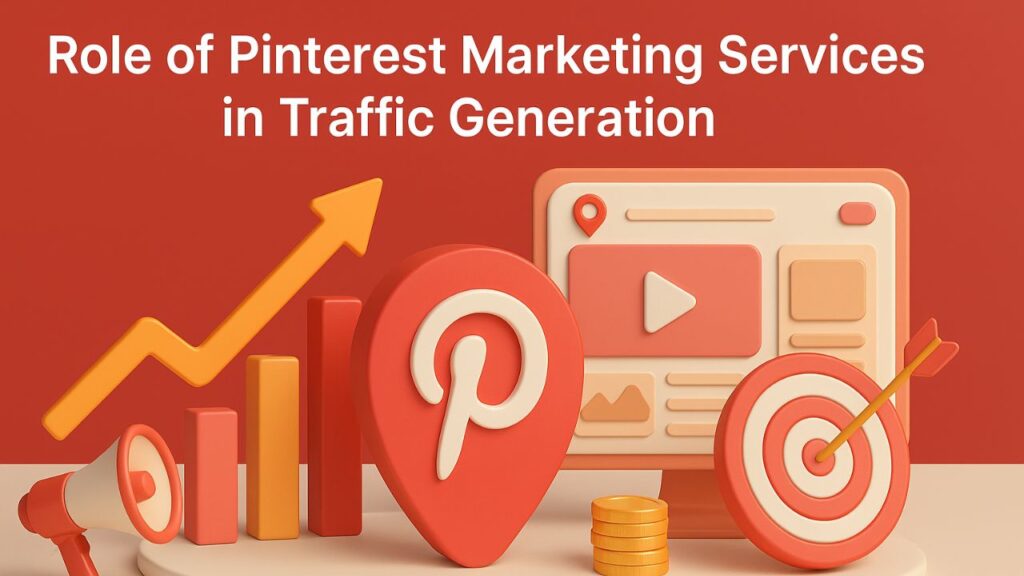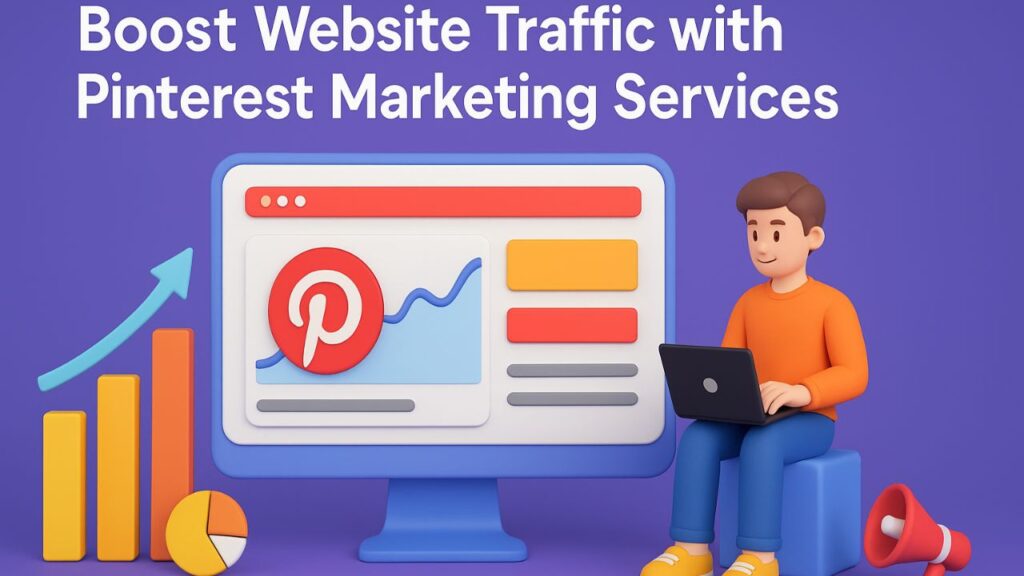In today’s digital ecosystem, image-based platforms continue to prove their dominance in driving online engagement and traffic. One such platform that remains powerful yet often underestimated is Pinterest. Known primarily for its visual appeal and discovery-driven structure, Pinterest has evolved into a strategic marketing platform with a focus on content discovery, product promotion, and traffic redirection.
This article explores how to boost website traffic with Pinterest marketing, focusing on best practices, strategic insights, and the role of Pinterest marketing services in making this possible. The information provided is designed to be purely educational, maintaining a professional tone without any dramatization or commercial endorsements.
Table of Contents
1. Introduction to Pinterest as a Marketing Platform
Pinterest is not just a platform for saving images and organizing ideas—it’s a powerful search engine for discovering new content and products. Unlike traditional social media platforms, Pinterest focuses on future planning and intent-driven discovery. Its algorithm and structure support long-term visibility, making it highly effective for consistent website traffic.
Businesses that understand how to align their content with Pinterest’s discovery model can reach highly targeted audiences at key moments in their decision-making journey. With a proper content strategy, brands can leverage Pinterest not just for engagement but as a substantial source of organic traffic.
2. Why Pinterest Matters for Website Traffic
Pinterest drives traffic differently than platforms such as Facebook or Instagram. When users engage with a pin, they are encouraged to explore the link further. The primary goal of the platform is to connect users with actionable ideas, which often means visiting the source website. This high intent makes Pinterest one of the most traffic-efficient platforms available today.
A well-executed Pinterest strategy can result in consistent traffic over time, unlike other social networks where content quickly becomes outdated. Pins can circulate for months—or even years—if they are optimized correctly. This longevity gives Pinterest marketing a unique advantage for sustainable website growth.
3. Understanding Pinterest Users and Their Intent
User intent is one of the core aspects of Pinterest’s success as a marketing channel. People come to Pinterest to plan and discover ideas, which often leads them to click through to external sites.
Unlike passive scrolling on other platforms, Pinterest users actively seek solutions, inspiration, and information. Whether searching for products, guides, or tutorials, users often transition from browsing to action. This makes the platform ideal for driving meaningful traffic that leads to conversions.
Pinterest users typically fall into categories like:
- Shoppers looking for product inspiration
- DIY enthusiasts seeking instructions
- Planners organizing ideas for future events
- Professionals gathering content for projects
Understanding these user behaviors is critical for tailoring content that matches intent and increases click-through rates.
4. How Pinterest Marketing Works
Pinterest marketing involves creating, optimizing, and distributing visual content that directs users to a specific online destination, typically a website or landing page. The strategy includes a blend of content planning, SEO, design, and data analysis.
The core workflow generally includes:
- Designing visually compelling pins
- Writing keyword-rich descriptions
- Linking to relevant website pages
- Scheduling content for consistent posting
- Tracking performance via analytics
To maximize these activities, many businesses invest in Pinterest marketing services to ensure expertise is applied across all touchpoints. These services help in aligning Pinterest’s unique algorithm with your business goals, ensuring higher engagement and click-through potential.
5. Key Elements of an Effective Pinterest Strategy
Creating an effective strategy on Pinterest requires a combination of creativity and data-driven decision-making. Some key elements include:
a. Niche Relevance
Focus on content that aligns with your business niche. Pinterest rewards thematic consistency, and users engage more with boards and pins that stay on topic.
b. Consistency in Pinning
Regular activity helps maintain visibility. Scheduling tools can assist in keeping content active without manual posting every day.
c. Keyword Optimization
Just like search engines, Pinterest uses keywords to serve content to the right users. Strategically placed keywords in pin titles, descriptions, and boards increase discoverability.
d. High-Quality Visuals
Pinterest is a visual-first platform. Clear, well-designed pins with a compelling layout are more likely to generate clicks.
e. Board Organization
Categorizing pins into relevant boards improves both user experience and SEO, helping Pinterest understand your content better.
6. Role of SEO in Pinterest Marketing
Pinterest has a powerful internal search engine. Each pin is indexed by keywords found in the title, description, and image file name. To boost traffic, applying SEO principles is essential.
Key SEO practices for Pinterest include:
- Keyword research using Pinterest’s search suggestions
- Optimizing pin titles with relevant keywords
- Writing detailed, natural-sounding descriptions
- Naming image files with target keywords before uploading
- Adding keywords to board titles and descriptions
By aligning SEO efforts with visual strategy, marketers can enhance the reach and performance of their pins, increasing website traffic organically over time.
7. Visual Content Best Practices for Pinterest
The visual nature of Pinterest demands design excellence. Effective pin designs capture attention while clearly communicating the message. Here are a few design tips:
- Use vertical formats (2:3 ratio, e.g., 1000×1500 pixels)
- Add readable text overlays to explain the image
- Stick to a consistent brand color palette
- Include a subtle call-to-action
- Avoid cluttered visuals or overly detailed images
Whether using in-house design or working through Pinterest marketing services, clarity and branding should always be prioritized in visual content.
8. Optimizing Pins for Maximum Clicks
Creating clickable pins is both an art and a science. In addition to visual design, copywriting plays a critical role in encouraging users to visit the linked page.
Tips to increase pin clicks:
- Use action verbs in pin titles (e.g., “Learn,” “Discover,” “Try”)
- Add urgency without sounding spammy
- Provide value upfront—what will the user gain by clicking?
- Link pins to relevant landing pages, not just homepages
- Avoid broken links or irrelevant destinations
A/B testing different variations of pin design and description can also reveal what drives higher click-through rates.
9. Pinterest Analytics and Data Interpretation
Understanding what works and what doesn’t is crucial for optimizing future campaigns. Pinterest’s native analytics platform offers insights into:
- Impressions
- Saves
- Click-throughs
- Engagement rates
- Audience demographics
This data can inform decisions like which topics to double down on, which pin formats perform best, and what times yield the highest engagement. Insights provided by Pinterest marketing services can often highlight trends that go unnoticed, helping refine ongoing strategies.
10. Integrating Pinterest with Website Strategy
Pinterest marketing should not exist in isolation. For it to drive sustainable traffic, it must be integrated into the broader digital strategy.
Integration points include:
- Adding Pin It buttons to website images
- Featuring popular pins on blog sidebars
- Embedding Pinterest boards on relevant landing pages
- Aligning website content themes with Pinterest trends
- Using UTM codes to track Pinterest-driven traffic in Google Analytics
These practices ensure that Pinterest functions as a natural part of the user journey from discovery to conversion.
11. Mobile Optimization and Pinterest Usage
The majority of Pinterest users access the platform via mobile devices. This makes mobile optimization a non-negotiable component of any Pinterest marketing strategy.
Ensure that:
- Linked website pages load quickly on mobile
- Landing pages are responsive
- Text is readable on smaller screens
- Buttons are touch-friendly
- Pin visuals are legible even in reduced size
High bounce rates from poorly optimized mobile sites can negate Pinterest’s traffic benefits, so addressing this area is essential.
12. Using Rich Pins and Product Pins Effectively
Rich Pins are a powerful feature for marketers, providing extra information directly on the pin. There are several types:
- Product Pins: Show real-time pricing and availability
- Article Pins: Include title, description, and author
- Recipe Pins: List ingredients and cooking times
By implementing Rich Pins, users are given more context, increasing trust and likelihood of clicks. Proper metadata integration is needed, and Pinterest marketing services often manage this technical implementation efficiently.
13. Pinterest Ads and Paid Promotions
While organic content has long-term value, Pinterest’s advertising platform offers targeting options to accelerate visibility and traffic. Ad formats include:
- Promoted Pins: Appear in relevant search results and feeds
- Video Pins: Combine motion with visual appeal
- Shopping Ads: Enable direct product purchases
- Carousel Pins: Showcase multiple images in a single pin
Targeting can be based on demographics, interests, keywords, and behavior. Paid campaigns can be used to test new content, retarget website visitors, or promote seasonal offers. When managed effectively, Pinterest Ads complement organic efforts and deliver measurable traffic gains.
14. Role of Pinterest Marketing Services in Traffic Generation

Managing a Pinterest strategy requires a blend of creative, technical, and analytical skills. Pinterest marketing services help streamline this by providing:
- Keyword research and SEO alignment
- High-quality pin design
- Content calendar development
- Data analysis and reporting
- Rich Pin integration
- Ad campaign management
These services ensure that every aspect of Pinterest activity is optimized for performance, increasing the likelihood of sustained and scalable website traffic growth.
15. Common Mistakes to Avoid
To ensure success with Pinterest, it’s essential to avoid these common pitfalls:
- Inconsistent Pinning: Infrequent activity limits reach
- Poor Quality Images: Blurry or unappealing visuals reduce engagement
- Weak Descriptions: Missing keywords or vague copy undercuts visibility
- Neglecting Mobile Optimization: Many users won’t wait for slow-loading sites
- Misaligned Links: Pins must connect to relevant, high-quality landing pages
Awareness of these issues can prevent wasted effort and lead to more efficient traffic-building strategies.
Conclusion
Pinterest offers a unique opportunity for businesses to grow their website traffic through consistent, visually-driven content that aligns with user intent. Unlike fleeting trends on other platforms, Pinterest content can deliver results over the long term, offering a high ROI when properly managed.
By understanding how to leverage Pinterest SEO, creating optimized visuals, and maintaining consistent engagement, brands can tap into a highly engaged audience actively looking for ideas and solutions. Leveraging professional Pinterest marketing services further ensures that the strategy remains competitive and impactful in a constantly evolving digital landscape.
Frequently Asked Questions (FAQs)
Q1: What type of content works best on Pinterest?
Content that is visually appealing, helpful, and aligned with user search intent performs best. This includes tutorials, product roundups, infographics, and inspirational content.
Q2: How often should I post on Pinterest?
Consistency is more important than volume. Posting several times a week—ideally daily—helps maintain engagement. Scheduling tools can help streamline the process.
Q3: Do I need a blog to benefit from Pinterest traffic?
While a blog can provide rich content to pin, product pages, landing pages, and visual galleries can also serve as strong traffic sources when optimized for Pinterest.
Q4: What’s the ideal image size for Pinterest pins?
A 2:3 aspect ratio is recommended, typically 1000×1500 pixels. This format maximizes screen space and visibility.
Q5: Can Pinterest marketing services help small businesses?
Yes. Pinterest marketing services provide strategic planning, visual creation, SEO alignment, and performance tracking, making them beneficial even for smaller brands looking to scale.
Q6: Are Pinterest Ads worth the investment?
When used strategically, Pinterest Ads can complement organic efforts, increase brand visibility, and drive immediate traffic to your website.
Q7: How long does it take to see traffic from Pinterest?
Organic Pinterest traffic often builds over weeks or months, as pins gain traction. However, with optimized content and consistent pinning, growth can be sustainable and long-lasting.
Q8: Is Pinterest still relevant for marketing in 2025?
Absolutely. Pinterest continues to evolve with advanced features and an algorithm focused on user intent. With the right strategy, it remains a valuable tool for traffic and visibility.



